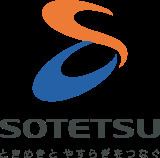Native name 相模鉄道株式会社 Services Passenger railway | Type K.K. (limited company) Area served Kanagawa Founded November 1964 | |
 | ||
Owner Sotetsu holdings (100%) CEO Shigeo Ozawa (30 Jun 2011–) Profiles | ||
fhd at yamato station on the sagami railway sotetsu main line
The Sagami Railway Co Ltd (相模鉄道株式会社, Sagami Tetsudō Kabushikigaisha), or Sotetsu (相鉄), is a railway company operating three lines in Kanagawa Prefecture, Japan. It ranks last of the 15 largest railways in Japan.
Contents
- fhd at yamato station on the sagami railway sotetsu main line
- Overview
- History
- Lines
- Passenger
- Freight
- Numbering
- Current
- EMUs
- Locomotives
- Preserved cars
- Proposed connection with Tokaido Freight Line
- References
Overview
Sagami Railway (Sotetsu) is one of the core companies of the Sotetsu group. Sotetsu focuses on railway operations, although formerly it had a more diversified set of holdings, such as bus lines and supermarkets. Sotetsu is the smallest company of the "Big 15" railways in Japan, as it has only short lines, but it succeeded in developing towns along its lines in the 1960s and 1970s, so many passengers ride this line. In May 1990, Sotetsu joined the major railways. In 2010 it had a daily ridership of 623,500
History
In January 1917, Sagami Railway KK was established at Chigasaki, Kanagawa to transport gravel along the Sagami River valley. The first section, between Chigasaki and Samukawa was opened in 1919, and the line was extended gradually to Hashimoto in 1931. Sagami Railway started direct operation to Hachioji, but performance was sluggish during the economic depression, so Sagami Railway became a subsidiary of Tokyu in 1941.
Jinchu Railway KK was also established at Seya village (now, Seya-ku, Yokohama) in 1917, and opened its first section from Futamatagawa to Atsugi in May, 1926. Jinchu Railway extended to Yokohama Station in 1933, but its management had financial difficulties, so the company also became a subsidiary of Tokyu in 1939, prior to Sagami Railway. The two companies' rail lines were connected at Atsugi Station.
In April 1943, Sagami Railway took over Jinchu Railway and named two lines "Sagami Line" (original section) and "Jinchu line" (acquired section). However, in June 1944, Sagami Line and Nishi-Samukawa branch line were purchased by the government to use the bypass between Tokaido main line and Chuo main line. At the same time, Imperial Japanese Navy Atsugi Airport was opened, so the number of passengers and amount of freight increased sharply. As a result, Sagami Railway released all management and delegated it to Tokyu. Under Tokyu, the line gained electrification to increase the carrying capacity and in 1944, all passenger sections was electrified.
In June 1947, Sagami Railway employees bought their own shares from Tokyu and resolved the commission.
In 1952, Sagami Railway purchased the 25,000 ㎡ land around Yokohama Station's west entrance from Standard Oil company, and began to develop to attract department stores.
Lines
The company operates two passenger (commuter) lines and a freight-only line. All lines are electrified.
Passenger
Freight
Numbering
from 2000 series EMU to 10000 series EMU, cars number is separated its function. But 11000 series don't keep this law. Point is last three figure of body number.
Current
EMUs
Locomotives
Preserved cars
Some of past cars are preserved at Kashiwadai depot.
Proposed connection with Tokaido Freight Line
The Sagami Railway and the Japan Railway Construction, Transport and Technology Agency are jointly planning a 2.7 km new line, called the Sotetsu JR Link Line (相鉄JR直通線, Sōtetsu JR Chokutsū-sen), connecting Nishiya Station on the Sōtetsu Line with the Tokaido Freight Line. The line, originally scheduled to be completed by 2015 will enable direct passenger services from Sōtetsu lines to Shinjuku Station in central Tokyo via the Yokosuka Line. As of December 2016, the line has not been opened.
